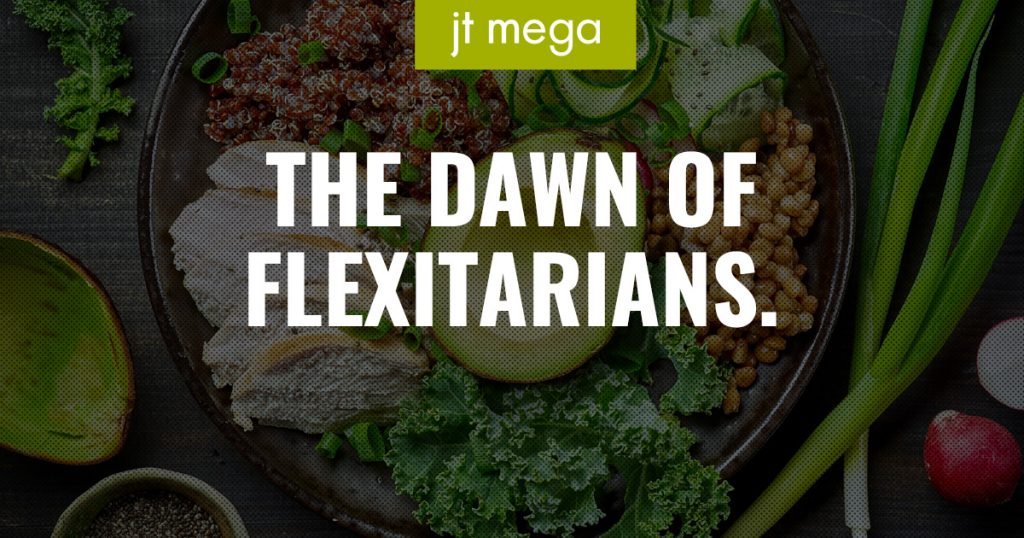Last month, casual dining chain TGI Fridays announced it was adding a buzz-worthy option to its 465 nationwide locations: The Impossible Burger. Made from all natural ingredients like wheat, coconut oil and potatoes, this plant-based burger is unique in that it bleeds, smells and sizzles like a regular beef patty thanks to a naturally-occurring iron compound called heme.
With less than 2% of the U.S. population identifying as vegan, many industry skeptics wonder why TGI Fridays believes a plant-based burger will thrive on a traditionally carnivorous menu.
The answer: Flexitarians.
WHY IT’S HAPPENING
A 2017 consumer survey by the Nielsen Group found that 40% of U.S. consumers were incorporating more plant-based foods into their diets. Not fully vegetarian or vegan, but consciously limiting their consumption of meat and meat byproducts, these new eaters are called flexible vegetarians, or simply, Flexitarians.
In a separate 2017 survey by Mattson, nearly 30% of U.S. adults said they followed one of two Flexitarian eating styles: Somewhat Vegetarian and Mostly Vegetarian.
Source: “What You Need to Know About the Meteoric Rise in Flexitarian Eating.” Mattson. August 2017.
What’s driving the shift towards plant-based cuisine? Based on Mattson’s research, consumers are drawn to plant-centric cuisine for health & wellness benefits and environmental concerns.
Source: “What You Need to Know About the Meteoric Rise in Flexitarian Eating.” Mattson. August 2017.
WHAT WE THINK
Investing in plant-based innovations is important, but widespread consumer adoption is still a ways off.
There is a significant movement with consumers experimenting and adopting more plant-centric diets. But 85% of the U.S. population is still eating meat and meat byproducts. Food and beverage companies should continue to look for relevant plant-based innovation opportunities, but set realistic volume and sales goals based on current consumer adoption trends.
WHAT’S NEXT
It’s important to keep the following in mind when vetting potential plant-based innovations:
# 1: Consider at-home vs. away-from-home consumption
According to Mattson’s research, 67% of consumers are most likely to try plant-based cuisine in a home environment. Meaning trial is more likely to happen in the grocery aisle than at a restaurant.
- 54% say they are most likely to try plant-based dishes at home
- 13% say they are most likely to try plant-based dishes at a friend or family’s home
- 33% say they are most likely to try plant based dishes away-from-home
# 2: Identify the need you intend to fulfill
For any plant-based product, the consumer needs must go beyond “I want a plant-based dish.” Is it intended to satisfy a craving for vegetable fare OR a craving for a traditional meat-based item made from plants? Is it meant to provide satiety and protein fulfillment OR the feeling of wellness associated with lighter, fresh ingredients? These answers will help craft your product narrative, and also help identify your target customer.
# 3: Know who your target customer is
Not all plant-based innovations will appeal to plant-seeking consumers in the same way. Here we see a consumer test of two plant-based burger concepts with two different “likely customer” outcomes:
Black Bean Burger
- Satisfies a craving for a plant-forward burger experience
- Most likely customers are Somewhat Vegetarians, Mostly Vegetarians, Vegetarians and Vegans
The Impossible Burger
- Satisfies a craving for a beef-burger experience but made with plant-based ingredients
- Most likely customers are Mostly Vegetarians, Vegetarians and Vegans
Source: “What You Need to Know About the Meteoric Rise in Flexitarian Eating.” Mattson. August 2017.
While True Omnivores may experiment with plant-based cuisine because of curiosity or a periodic craving, they shouldn’t be counted on to drive sales of plant-based innovations either at home or on the menu.
What does this all mean for TGI Fridays? Because their core menu is centered around traditional meat and meat byproducts, it could be a challenge to get vegetarian-leaning consumers in the door for just one item. After the initial excitement wears off, time will tell if their traditional (True Omnivore) customer-base can sustain the item long term.
